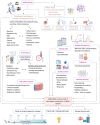New Perspectives on the Importance of Cell-Free DNA Biology
- PMID: 36140548
- PMCID: PMC9497998
- DOI: 10.3390/diagnostics12092147
New Perspectives on the Importance of Cell-Free DNA Biology
Abstract
Body fluids are constantly replenished with a population of genetically diverse cell-free DNA (cfDNA) fragments, representing a vast reservoir of information reflecting real-time changes in the host and metagenome. As many body fluids can be collected non-invasively in a one-off and serial fashion, this reservoir can be tapped to develop assays for the diagnosis, prognosis, and monitoring of wide-ranging pathologies, such as solid tumors, fetal genetic abnormalities, rejected organ transplants, infections, and potentially many others. The translation of cfDNA research into useful clinical tests is gaining momentum, with recent progress being driven by rapidly evolving preanalytical and analytical procedures, integrated bioinformatics, and machine learning algorithms. Yet, despite these spectacular advances, cfDNA remains a very challenging analyte due to its immense heterogeneity and fluctuation in vivo. It is increasingly recognized that high-fidelity reconstruction of the information stored in cfDNA, and in turn the development of tests that are fit for clinical roll-out, requires a much deeper understanding of both the physico-chemical features of cfDNA and the biological, physiological, lifestyle, and environmental factors that modulate it. This is a daunting task, but with significant upsides. In this review we showed how expanded knowledge on cfDNA biology and faithful reverse-engineering of cfDNA samples promises to (i) augment the sensitivity and specificity of existing cfDNA assays; (ii) expand the repertoire of disease-specific cfDNA markers, thereby leading to the development of increasingly powerful assays; (iii) reshape personal molecular medicine; and (iv) have an unprecedented impact on genetics research.
Keywords: cell-free DNA; cfDNA; circulating tumor DNA; ctDNA; liquid biopsy.
Conflict of interest statement
The authors declare no conflict of interest.
Figures









References
Publication types
LinkOut - more resources
Full Text Sources
Other Literature Sources
Research Materials

